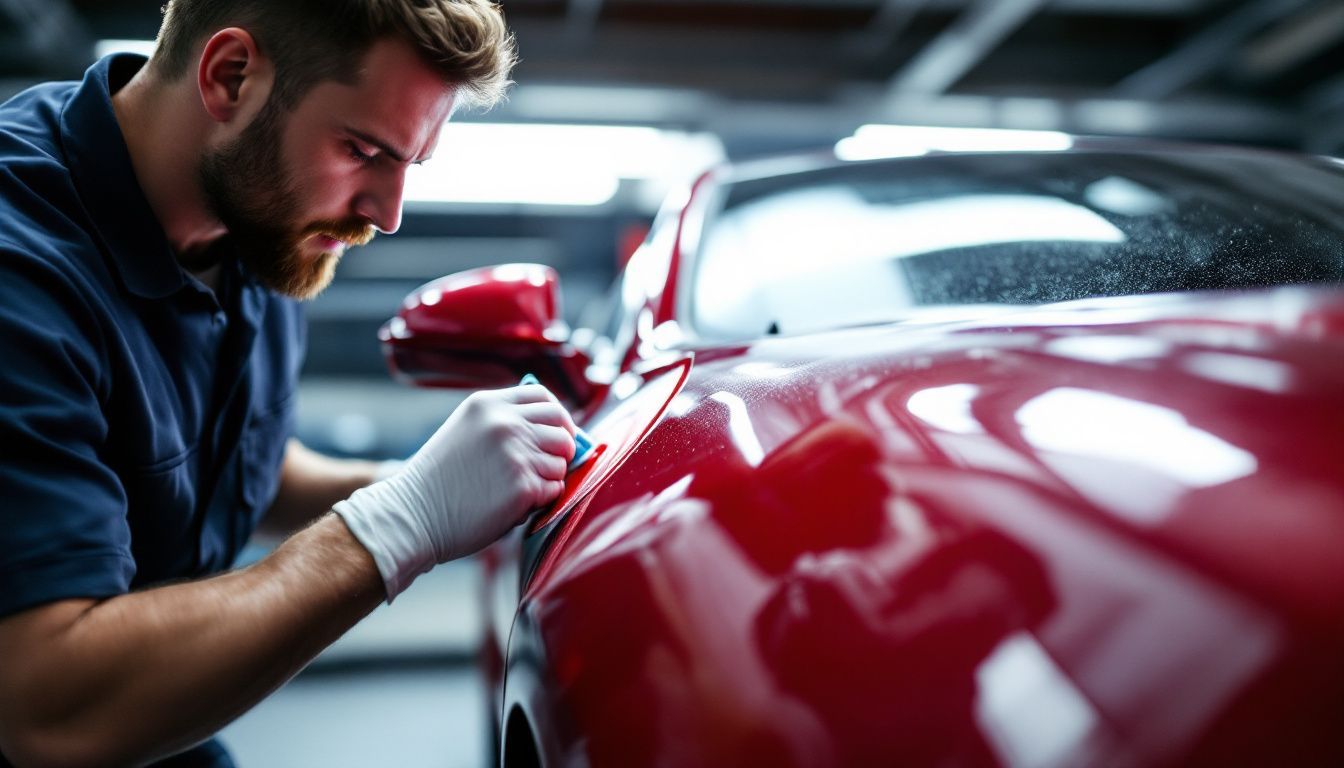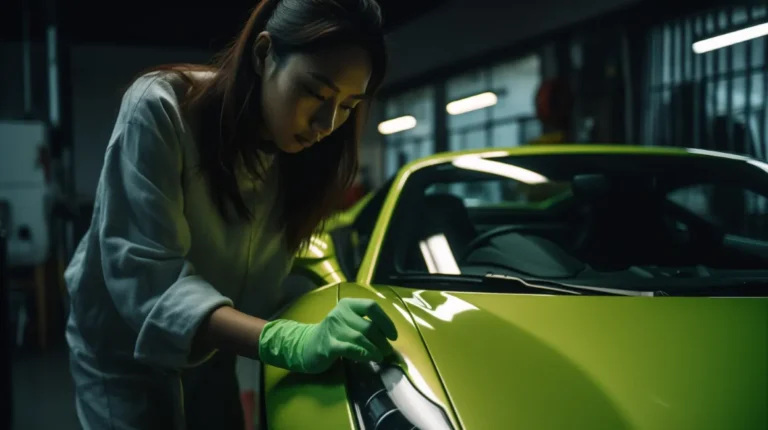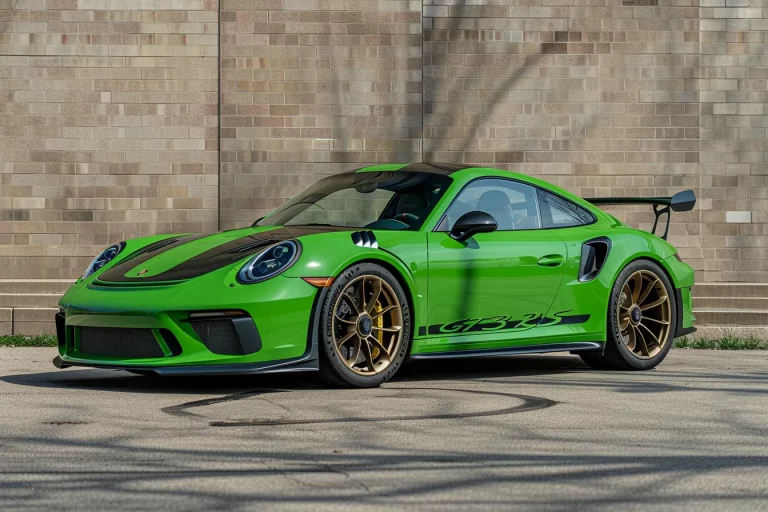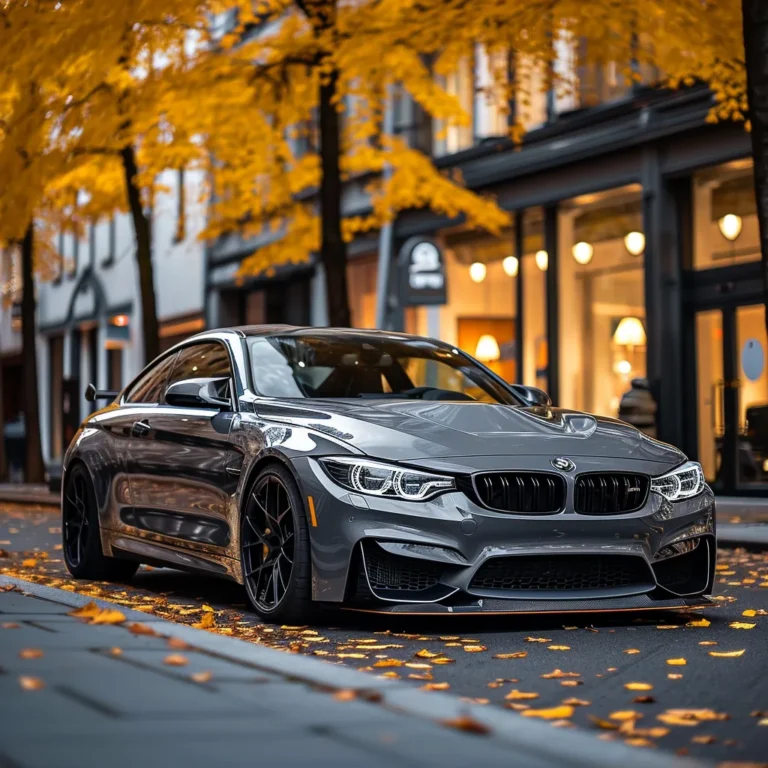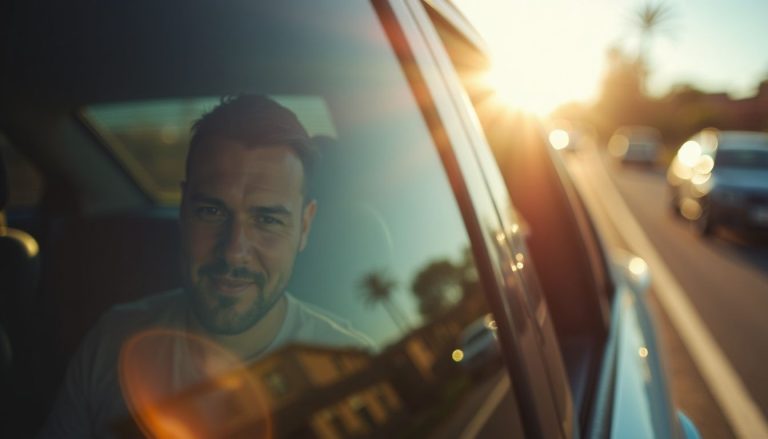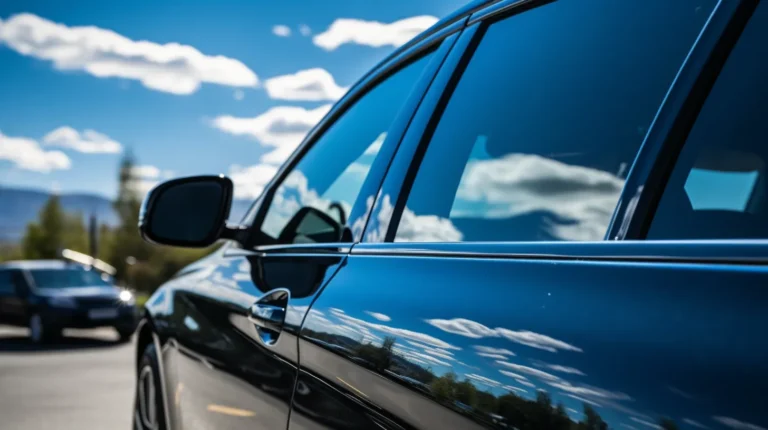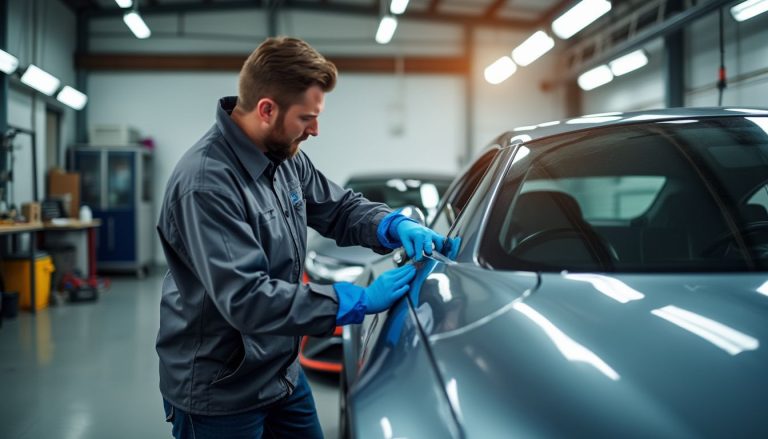Ceramic Coating vs. Paint Protection Film: Which One Is Right for Your Car?
Choosing the right protection for your car’s paint can be a tricky decision. With options like Ceramic Coating and Paint Protection Film (PPF), it’s easy to get lost in all the jargon and marketing hype.
But, understanding the difference between ceramic coating vs. paint protection film is crucial for keeping your car looking shiny and new.
I’ve spent years testing different ways to protect car paints from scratches, UV rays, and road debris. Through trial and error, I’ve found that both PPF and ceramic coatings have their unique benefits.
Ready to find out which one suits your ride best? Let’s get started!
Key Takeaways
- Ceramic Coating sticks to your car’s paint and keeps it looking shiny. It fights off water and dirt, making cleaning easy.
- Paint Protection Film (PPF) is a thick layer that protects against scratches and sun damage. It can heal small marks by itself.
- Using both Ceramic Coating for shine and water resistance, with PPF for scratch protection in risky spots, offers the best care for your car.
- Both options help maintain your car’s value by keeping the look new over time. But PPF costs more because it gives better physical protection.
- Regular washing keeps both Ceramic Coating and PPF in good shape, but they have their limits. Ceramic isn’t as strong against physical hits as PPF is.
What Are Ceramic Coating and Paint Protection Film?
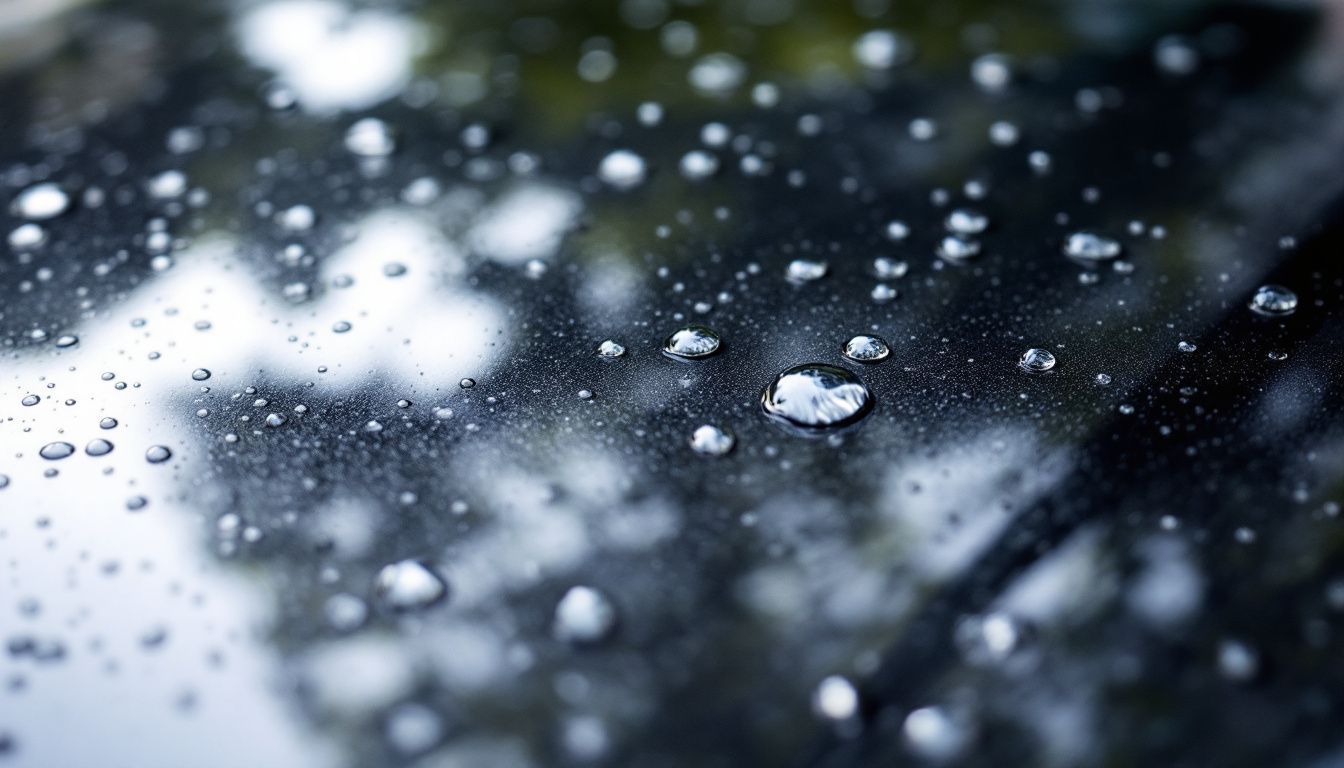 Ceramic Coating is a liquid polymer that sticks chemically to a car’s paint. It adds a permanent protective layer and makes the surface water-repellent. This means dirt and grime slide off easier, keeping your vehicle looking glossy without as much scrubbing.
Ceramic Coating is a liquid polymer that sticks chemically to a car’s paint. It adds a permanent protective layer and makes the surface water-repellent. This means dirt and grime slide off easier, keeping your vehicle looking glossy without as much scrubbing.
Paint Protection Film (PPF), on the other hand, is a thick thermoplastic urethane cover that guards against scratches, chips from small rocks on the road, and sun damage. PPF is like a clear bra for your car’s most hit spots – it can even heal itself from minor marks.
Both these protectors help keep your car’s paint job in top shape against UV rays and nasty contaminants. Think of Ceramic Coating as your car’s long-lasting sunscreen that also keeps it shiny, while PPF acts more like heavy-duty armour where it counts most.
Plus, they boost what your ride is worth by reducing wear and tear over time. For those wanting ultimate safety for their vehicles, mixing both—with Ceramic Coating all over and extra-tough PPF in high-risk areas—is often suggested.
It’s crucial to know why protecting your car’s paint matters next.
Why Is Car Paint Protection Important?

Protecting car paint matters a lot. It keeps the car looking shiny and new over time. Think about it: cars face many threats every day. Things like rock chips, water spots, and UV rays can damage the paint.
This is where things like ceramic coatings and paint protection films (PPF) come into play.
Ceramic coatings create a strong shield on top of the car’s paint. They make the car easier to clean because of their hydrophobic properties—meaning they repel water. PPF, on the other hand, acts like a superhero skin for your car.
It absorbs impacts from stones and reduces harm from scratches and swirl marks. By using these protections, you guard your vehicle against harsh elements that wear down its looks.
Using either of these protections means keeping your vehicle’s value higher for longer too. A well-kept appearance from quality paint protection can be a big deal when selling your car down the track.
Both options offer an invisible finish that boosts aesthetics while doing all this hard work behind scenes to fight off damaging factors like abrasion from road debris or harsh weather effects.
What Will This Article Cover?

This piece will explore the competition between car care giants: Paint Protection Film (PPF) and ceramic coating. We’ll examine PPF, its self-repairing magic, and how it defends your vehicle from scratches.
Then, we’ll shift our focus to ceramic coatings. This liquid armour not only forms a tight bond with your vehicle’s paint but also introduces hydrophobic traits for a lasting clean appearance.
Moreover, we’re going to discuss costs frankly, as car protection shouldn’t be financially burdensome.
We’re also preparing direct comparisons—like which one offers better protection from UV rays, or which choice makes maintaining your car’s appearance easier? Every driver desires their vehicle to stay in prime condition for as long as feasibly possible, correct? Thus, let’s get down to business and decide whether to clad your car in this thermoplastic urethane film or opt for a full ceramic coating.
Nothing can compare to the satisfaction of your car appearing brand new every day.
Let’s proceed to gain a better understanding of ceramic coatings…
Understanding Ceramic Coating

Jumping right in, ceramic coating is like a superhero outfit for your car. This liquid polymer forms a close bond with the factory paint, giving it a durable layer of protection. It’s not just about looking shiny; this coating has hydrophobic properties.
That means it keeps water off your car’s surface, making dirt and grime less likely to stick. Because of this, cleaning becomes a breeze.
Ceramic coatings offer more than just ease of cleaning. They also protect against UV rays from the sun, which can fade and damage paint over time. Plus, they add an extra gloss to your car’s appearance, making it look newer for longer.
Think of it as putting on sunscreen and then finishing with a sparkling highlighter – protection plus beauty all in one go!
What Exactly Is Ceramic Coating?

Ceramic coating is a tough layer you can put on your car’s paint. It acts like a shield and sticks to the paint for ages. Think of it as sunscreen for your car, but instead of reapplying every few hours, it lasts years.
This shield keeps away water and dirt, making your car easier to clean.
The magic in ceramic coating comes from its ingredients, mainly liquid polymer. When the coating bonds with the factory paint, it forms an invisible coat. This coat fights off nasty stuff like UV rays that can fade your paint over time.
Plus, it makes your car look shiny and new by keeping away oxidation and chemical etching.
Putting on ceramic coating isn’t just about making cleaning simpler or keeping the coloured surfaces looking good. It’s also about peace of mind—knowing that small scratches won’t reach the real paint underneath easily.
With properties that push water away, cleaning takes less elbow grease than before. Just imagine: fewer chemicals damaging the exterior means more charm stays intact long-term.
How Does Ceramic Coating Work?

So, we’ve covered the essence of what ceramic coating is. Now let’s move on to how this substance genuinely operates on your vehicle. Visualise it as a highly resilient barrier, similar to sunscreen for your car’s paintwork.
This liquid polymer clings to the factory paint due to its chemical makeup, creating a firm bond that resists detaching. It adds an extra shield over the original paintwork.
This layer isn’t just ordinary, though. It’s resilient against chemicals, prevents UV rays from bleaching the colour, and tolerates high temperatures without exhibiting stress. Plus, it showcases an interesting feature where water simply beads up and slides off it rather than lingering — resulting in fewer dirt particles.
And since it enhances your car’s shine while also simplifying cleaning, you won’t need to clean it as frequently. But keep in mind, while ceramic coatings are exceptional at repelling chemical damage and maintaining cleanliness, they’re not bulletproof barriers against extensive scratches or rock chips like Paint Protection Film (PPF) provides.
What Are the Benefits of Ceramic Coating?

Ceramic coating is like a superhero shield for your car. It bonds with the paint, giving it powerful protection. Here’s why you should consider it:
- Acts as a permanent protector by creating a strong bond with the factory paint. This means your car stays safe from everyday damage.
- Gives top-notch chemical resistance against nasty stuff like bird droppings and tree sap that can stain or etch the paint.
- Blocks UV rays to prevent fading, keeping your car’s colour vibrant and shiny under the Australian sun.
- Delivers scratch resistance, making your car more resilient to chips and scratches that happen while driving.
- The hydrophobic properties make cleaning a breeze since water and dirt just slide right off.
- Keeps your car looking newer for longer by maintaining the glossiness of the vehicle’s paint.
- Offers long-lasting protection, which means you don’t have to reapply it every few months like wax.
- Reducing the risk of chemical stains and etch marks helps keep your car looking spotless without constant touch-ups.
- When used with Paint Protection Film (PPF), it provides even greater defence against environmental damage, ensuring all parts of your vehicle are covered – from the front bumper to the whole car exterior.
- Makes maintenance easier as substances find it hard to stick, saving you time and effort in keeping your vehicle looking prime.
By choosing ceramic coating, you’re not just protecting your paint; you’re ensuring that cleaning becomes less of a chore while also boosting the appearance and resilience of your vehicle against daily wear and tear.
Does Ceramic Coating Provide Long-Lasting Protection?

Ceramic coating forms a lasting shield by bonding with the car’s factory paint. It offers advanced protection from UV rays, heat, scratches, and chemical damage compared to traditional waxing methods.
The hydrophobic properties of ceramic coatings make it harder for dirt and grime to stick onto the vehicle’s surface, simplifying cleaning.
When applied correctly, ceramic coating can last for the entire lifespan of the vehicle. This makes it a cost-effective way to uphold the quality of your car’s paint job over time.
Moreover, it provides an additional layer of defense against environmental factors that could harm the underlying paint on exterior surfaces.
In summary, ceramic coating establishes durable protection through its ability to merge with the car’s original paintwork while delivering higher resistance against various elements that may impact its appearance.
How Does It Enhance the Vehicle’s Appearance?

Ceramic Coating elevates the vehicle’s appearance by producing a lustrous and well-preserved finish. The water-repellent quality of this coating prolongs the cleanliness of the car, upholding the vividness of its paint.
Moreover, Paint Protection Film (PPF) is nearly undetectable, defending the aesthetics of the vehicle while absorbing minor scratches and upholding its surface integrity. By incorporating PPF and Ceramic Coating, you not only strengthen your car against environmental harm but also optimise its resale value by maintaining a newer look over an extended period.
Is It Easy to Maintain?
Maintaining ceramic coating is a breeze due to its hydrophobic nature, making it easy to clean. Regular washing does the trick for upkeep – no need for constant waxing. For paint protection film (PPF), minor scratches can self-heal, reducing the need for frequent touch-ups.
Its maintenance also involves regular washing, making both options fairly low-maintenance. Combining PPF and Ceramic Coating provides enhanced protection while keeping maintenance hassle-free.
In terms of ease of maintenance, Ceramic Coating requires less effort because it eliminates the need for frequent waxing and has hydrophobic properties that make cleaning easier. On the other hand, PPF’s ability to self-heal from minor scratches reduces the need for touch-ups and simplifies upkeep through regular washing.
When considering hassle-free maintenance with superior protection, combining both options offers an optimal solution.
Are There Any Drawbacks to Ceramic Coating?
Applying ceramic coating has drawbacks:
- Reduced protection against physical damage such as rock chips and scratches compared to paint protection film (PPF).
- It does not offer the same level of abrasion resistance as PPF, leaving vulnerable areas exposed to potential damage.
- The cost is generally lower than PPF, but it lacks extensive physical damage protection.
- Without PPF, susceptible areas of the car may remain at risk of damage.
That’s all for the drawbacks of ceramic coating.
What Are the Costs Involved?
Before we talk about the costs, it’s important to know that both ceramic coating and paint protection film (PPF) can vary in price depending on factors such as the size of your vehicle and the level of coverage you choose.
Paint Protection Film generally comes with a higher cost due to its comprehensive protection against chips, scratches, and physical damage. On the other hand, Ceramic coatings are usually less expensive but still provide excellent paint protection.
The pricing for both PPF and ceramic coatings can also differ based on material quality.
Professionals may recommend combining PPF and ceramic coating for optimal protection while balancing costs. There’s a hybrid approach using PPF on the front part of your car – providing better protection at a lower cost compared to covering the entire vehicle with PPF or ceramic coating alone.
How Does It Compare to Other Protection Methods?
When comparing Ceramic Coating and Paint Protection Film (PPF), it’s important to consider their unique features. PPF provides superior protection against road debris and rock chips, with self-healing properties that allow it to recover from minor damage.
On the other hand, Ceramic Coating offers hydrophobic properties for easy cleaning and UV ray protection to preserve the car’s paintwork.
While PPF is thicker and better at absorbing impacts, Ceramic Coating enhances the vehicle’s glossiness and appearance. Combining both methods may result in maximum protection against environmental wear.
However, PPF generally comes at a higher cost due to its extensive protective capabilities, while Ceramic Coating is usually less expensive.
In terms of durability, PPF has an edge in impact resistance but can be more costly compared to the long-lasting benefits of Ceramic Coating. When considering these choices, it’s essential to weigh factors like cost-effectiveness, level of protection required, ease of maintenance, and impact on your car’s appearance.
Exploring Paint Protection Film (PPF)
Now that we’ve explored Ceramic Coating, let’s direct our attention to Paint Protection Film (PPF). PPF is a protective film constructed of thermoplastic urethane. It possesses self-repairing features, meaning minor scratches can vanish independently.
This film boasts greater thickness than Ceramic Coating and delivers exceptional protection against road debris, rock chips, and other potential damage.
When it comes to applying PPF, it can be placed on vulnerable areas of the car such as the front bumper, hood, and side mirrors. It serves as a shield against environmental elements and harmful UV rays.
Owing to its comprehensive protective capabilities, the cost of applying PPF is generally higher compared to Ceramic Coating.
In summary, Paint Protection Film (PPF) offers durable protection for your vehicle’s exterior surfaces by serving as a barrier against different forms of damage while delivering sturdy defense against environmental factors such as UV rays and road debris.
What Is Paint Protection Film?
Paint Protection Film (PPF) is a thin, malleable thermoplastic urethane film that’s nearly invisible when applied to the exterior of a vehicle. It acts as a shield against chips, scratches, and other damages while preserving the car’s appearance.
PPF offers UV protection, safeguarding against paint oxidation and fading over time. Its self-healing properties enable it to recover from minor damages such as small scratches and impacts, protecting your car’s paint for years to come.
The film also defends against environmental damage like water spots, mineral marks, and chemical stains. Being thicker than ceramic coatings, it provides superior protection against abrasions from road debris.
For optimal safeguarding, experts recommend combining PPF with ceramic coating: applying PPF to vulnerable areas for enhanced defense alongside ceramic coating for an improved gloss finish and hydrophobic functionality.
How Is Paint Protection Film Applied?
Paint protection film (PPF) is applied to cars as a transparent layer of protection. It’s primarily used to safeguard areas prone to damage, such as the front bumper, hood, fenders, side mirrors, rocker panels, and rear wheel arches.
PPF is created from thermoplastic urethane film and aims to shield the car’s paint while being almost invisible. This process preserves the aesthetic appeal of the vehicle while providing added defense.
During application, professionals carefully place the film on these vulnerable spots with precision to ensure thorough coverage without compromising the appearance or performance of your ride.
A unique feature of PPF is its self-repairing properties; it can recover its original form after suffering minor damages – ensuring that your car maintains its flawless look for an extended period.
What Are the Benefits of Paint Protection Film?
Paint Protection Film (PPF) provides several benefits for your vehicle:
- PPF offers robust protection against chips, scratches, and stains, keeping your car looking new for years.
- It features self-healing properties that allow it to recover from minor damage without visible scarring.
- The film provides UV protection, preventing paint oxidation and maintaining the car’s appearance over time.
- PPF is nearly invisible when applied, preserving the vehicle’s aesthetic appeal while providing extensive protection.
- It effectively guards against various damages such as water spots, mineral marks, and chemical stains.
- Proper application of PPF can significantly extend the lifespan and value of a vehicle’s paintwork.
This completes the list of benefits provided by Paint Protection Film (PPF).
Does PPF Offer Superior Scratch Resistance?
Now, let’s shift the focus to the scratch resilience feature of paint protection film (PPF). According to vital information, PPF is crafted from thermoplastic urethane film, providing it with exceptional scratch resilience.
Furthermore, it possesses self-repairing properties that absorb minor scratches and chips. When compared to ceramic coating, PPF outshines in shielding against abrasions from road debris and offers superior physical damage resilience due to its specific composition.
The information indicates that combining both PPF and Ceramic Coating is advisable for optimal protection – the efficacy of PPF in scratch resilience should be a crucial factor when determining vehicle protection requirements.
How Does PPF Protect Against Environmental Damage?
PPF shields car paint from environmental harm like rock chips, scratches, and acidic substances. It’s made of thermoplastic urethane film and offers a malleable self-healing solution.
PPF also gives UV protection, preventing paint oxidation and fading over time. Its self-healing properties help it recover from minor damages, keeping an invisible finish intact. Plus, it stops water spots and mineral marks, ensuring the surface stays clean and protected.
When combined with Ceramic Coating, PPF enhances protection against both physical and environmental damage.
Is It Removable and Repairable?
Moving from considering how PPF safeguards against environmental damage, it’s crucial to ponder whether the film is removable and repairable. It’s positive news – PPF shields can be removed without causing any damage to the paint beneath it, allowing for a fresh installation if needed.
When properly applied, this shield provides a layer that can be replaced in case of damage or wear. Furthermore, should any part of the film encounter scratches or abrasions, localised fixes are feasible without having to replace the entire shield.
Besides, some advanced paint protection films come with self-healing properties which help the material to recover from minor scratches and blemishes on its own. This feature offers an added level of protection and longevity.
Overall, PPF stands out as not only providing strong defence against various types of harm but also offering flexibility through its removability and repairability features.
Given these considerations about paint protection films’ capacity for removal and repair while maintaining structural integrity proves favourable when compared against other automotive protective options like ceramic coatings or traditional waxing methods.
What Are the Potential Drawbacks of Paint Protection Film?
Paint Protection Film, also known as PPF, has certain drawbacks to consider:
- PPF can be more expensive than a ceramic coating, making it a considerable investment.
- Over time, the film may start to show signs of yellowing or discolouration, affecting the appearance of your vehicle.
- If the film becomes damaged, it may require professional repair or replacement to maintain its protective properties.
- Installation of PPF requires precision and expertise, and any errors during application can result in unsightly imperfections on the vehicle’s surface.
- Removing PPF can be a labor-intensive process, potentially leaving adhesive residue that needs thorough cleaning.
This comprehensive outline helps you weigh the disadvantages of Paint Protection Film against its benefits when considering car paint protection options.
Is It More Expensive Than Ceramic Coating?
Paint Protection Film (PPF) generally comes at a higher price compared to Ceramic Coating. The additional cost reflects PPF’s comprehensive physical damage protection, whereas Ceramic Coating is a more economical option, known for its excellent chemical resistance and UV protection.
Both PPF and Ceramic Coating’s pricing fluctuates based on the size of the vehicle, the covered areas, and the quality of the materials. PPF possesses self-healing properties, which contribute to its value.
A combined approach using both options can be cost-effective and still offer great protection.
Can It Alter the Look of My Vehicle?
Now, let’s talk about whether the paint protection film (PPF) can change how your car looks. PPF is a clear film that goes on your vehicle to shield the paint from scratches and chips without changing its appearance.
It’s almost invisible and keeps your car looking just like it did before.
The PPF shields against abrasions while maintaining the original colour of your vehicle. This means you won’t have to worry about dullness or discolouration caused by environmental factors over time.
The transparent nature of PPF ensures that no alterations are made to your car’s natural look, allowing you to enjoy a protected and pristine exterior for years to come.
Paint Protection Film: A Side-by-Side Comparison
Alright, mates, let’s dive straight into the battle of car protectors: Ceramic Coating vs. Paint Protection Film (PPF). We’re looking at two tough choices for keeping your car looking sharp. So, without further ado, let’s get into the nitty-gritty.
| Feature | Ceramic Coating | Paint Protection Film (PPF) |
|---|---|---|
| What is it? | A liquid polymer that bonds with the paint | A thermoplastic urethane layer |
| Protection | Chemical resistance, UV protection, light scratch resistance | Chips, scratches, UV rays, contaminants |
| Impact on appearance | Enhances gloss and shine | Can alter the look slightly |
| Longevity | Permanent, but may require top-up | Self-healing, lasts for years |
| Cost | Less expensive than PPF | Generally more expensive |
| Main drawback | No protection against physical damage | More expensive; can be noticeable |
| Maintenance | Easier to maintain | Removable and repairable |
So, there you have it! Whether it’s the shiny, ease-of-maintenance Ceramic Coating or the tough, impact-resistant PPF, your choice depends on what your car goes through and what you want from a protector. Both have their pros and cons, but one thing’s for sure – they are top-notch choices to keep your car looking its best.
How Do They Differ in Terms of Durability?
When comparing Ceramic Coating and Paint Protection Film (PPF), their durability varies significantly. PPF offers a thicker layer of protection, giving it superior resistance to abrasions like rock chips and scratches.
It also has self-repair properties that enable it to restore its original form after minor damage. On the other hand, Ceramic Coating forms a permanent protective layer that chemically bonds with the car’s paint, enhancing durability over time.
Although Ceramic Coating provides excellent protection against UV rays and chemical etching, it does not prevent damage from rock chips and scratches as effectively as PPF.
It’s essential to keep in mind that combining PPF and Ceramic Coating can provide optimal long-term preservation and protection for a vehicle’s paint. In addition, the durability of Ceramic Coating is significantly enhanced when applied over PPF.
While PPF generally has a higher upfront cost due to extensive physical damage protection, Ceramic Coating is typically more cost-effective but offers different types of protection.
Which Option Offers Better Protection Against UV Rays?
Both Ceramic Coating and Paint Protection Film, commonly known as PPF, shield your car from harmful UV rays. Ceramic Coating acts like a sunscreen to safeguard against the oxidation caused by sunlight exposure.
It also repels water and contaminants due to its hydrophobic nature, maintaining the paint’s vibrancy. On the other hand, PPF absorbs UV rays and prevents fading while offering self-healing properties.
Furthermore, PPF provides superior scratch resistance and protects against chip damage.
Concerning protection against UV rays specifically, both options offer formidable defence mechanisms for your vehicle’s paintwork. However, employing them together provides an optimal solution – with PPF guarding against physical damage and Ceramic Coating enhancing UV protection.
This combined approach offers comprehensive protection against environmental hazards.
In summary, both Ceramic Coating and PPF offer substantial safeguards against UV rays; however, when used in combination, they provide a tailored shield of ultimate protection for your vehicle’s exterior surfaces.
How Do They Compare in Terms of Cost?
Considering the superior physical damage protection, paint protection film (PPF) typically comes at a higher cost compared to ceramic coatings. We recommend balancing cost and coverage by choosing a combination of both methods rather than relying solely on one protective measure.
Always keep in mind that prices are influenced by various factors like vehicle size, areas covered, as well as material quality. This will assist in making an informed decision about which method best suits your needs without overspending or compromising on the overall safeguarding of your vehicle’s exterior surfaces.
Which Option Is Easier to Apply and Maintain?
Ceramic coating is the easier option to apply and maintain. It bonds with the vehicle’s paint, providing a protective layer that lasts longer. On the other hand, Paint Protection Film (PPF) requires professional installation, making it more complicated to apply.
Ceramic coating offers superior hydrophobic properties, which means cleaning is much easier compared to PPF. Although PPF has self-healing properties that reduce maintenance needs, ceramic coating’s easy maintenance makes it a more preferred choice for many car owners.
Combining both ceramic coating and PPF can make long-term maintenance even easier. The decision of which option to choose depends on individual preferences for application ease and ongoing maintenance requirements.
How Do They Affect Resale Value?
Ceramic coating and paint protection film (PPF) can significantly enhance the resale value of a car. PPF provides superior protection against chips, scratches, and road debris, positively impacting resale value.
Similarly, vehicles with ceramic coating generally command higher resale prices due to their well-maintained appearance and long-lasting protection, reducing the need for frequent detailing.
It is advisable to invest in either PPF or ceramic coating, as it helps in preserving your investment and maximising the resale value of your vehicle. Combining both options not only offers comprehensive protection but also effectively enhances the vehicle’s appeal to potential buyers.
The combination of PPF and Ceramic Coating maintains a car’s aesthetics better than using only one protective method, which results in attracting higher resale prices for vehicles that exhibit good exterior condition over time.
Their influence on how a buyer perceives your vehicle determines its market price; prospective buyers are likely to pay more for cars that show minimal wear and tear attributed to these protective technologies.
This contribution is invaluable when negotiating fair market values when selling your car in Australia. Understanding how these protective methods contribute to maintaining a vehicle’s aesthetic appeal is crucial when seeking more than just basic care.
Investing upfront saves money over time by avoiding expensive repairs or reconditioning treatments prior to sales transactions, preparing you for an advantageous sale outcome in today’s fast-paced automotive trade realm.
Factors to Consider When Choosing Between Ceramic Coating and PPF
When deciding between Ceramic Coating and PPF, it’s crucial to consider the level of protection needed. PPF provides superior defense against rock chips and road debris abrasions, while Ceramic Coating is more cost-effective and enhances gloss with a hydrophobic effect.
Another important factor is UV exposure protection, where both options offer similar benefits. However, self-healing properties are exclusive to PPF while Ceramic Coating focuses on enhancing the appearance of the vehicle.
It’s also essential to weigh cost considerations. While Ceramic Coating generally costs less than PPF, the latter offers extensive physical damage protection. Combining both approaches can effectively combat watermarks, acid damage, and oxidation, as well as enhance scratch resistance and maintain a vehicle’s resale value.
FAQs
1. What’s the difference between ceramic coating and paint protection film (PPF) for your car?
Ceramic coating is a clear coat that protects painted surfaces, while PPF is a film applied to protect your paint from damaging impacts like paint chips.
2. How can ceramic coatings enhance my car’s look?
Ceramic coatings can be used on exterior surfaces of a vehicle to keep the car looking new for years to come! It’s nothing quite like the feeling of driving around in a shiny, well-protected vehicle.
3. Can I use both PPF and ceramic coating on my car?
Yes, you sure can! Using both gives you the best of both worlds – impact protection from PPF and glossy finish from ceramic coatings.
4. Is there any need for paint correction before applying these protective layers?
Absolutely! Paint correction ensures any existing flaws are fixed before protecting it with either PPF or ceramic coating.
5. Which one is more cost-effective between PPF vs Ceramic Coating?
The cost of PPF installation might be higher initially but remember, it offers robust protection compared to ceramic coatings which may require reapplication over time!
6. So what’s the best way to protect my precious ride then?
It all depends mate! If you’re after heavy-duty protection against physical damage, go for PPF; if you want that gloss-enhanced look with some level of protection too – opt for ceramics.

